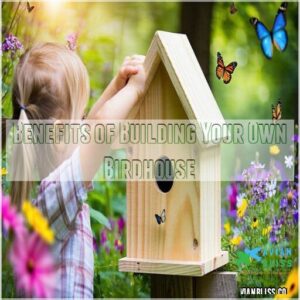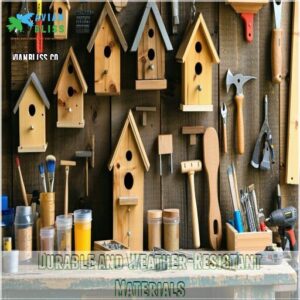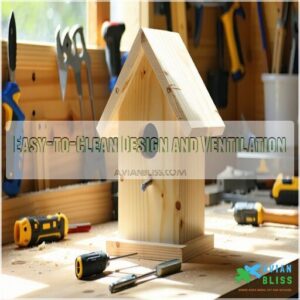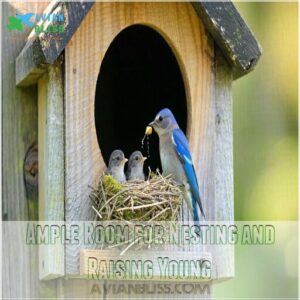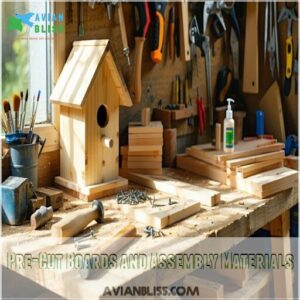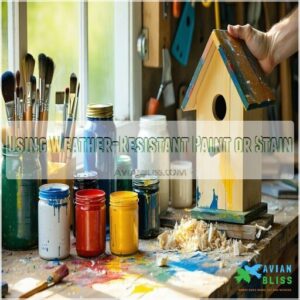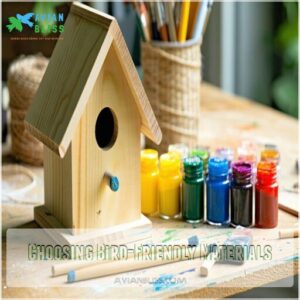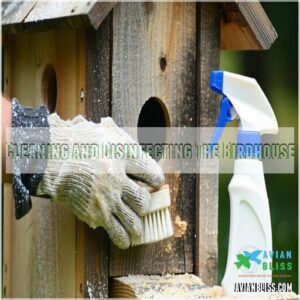This site is supported by our readers. We may earn a commission, at no cost to you, if you purchase through links.

These kits typically include pre-cut wooden panels, screws, and instructions, making assembly straightforward for kids and adults alike.
Look for durable, weather-resistant materials to guarantee your birdhouse stands up to the elements, and consider kits with paint options for added creativity.
Installing a birdhouse in the right spot—away from predators and facing the right direction—can attract specific bird species to your yard, making it a great way to connect with nature.
Whether it’s a family craft day or a solo project, these kits offer a rewarding way to engage with the outdoors.
Table Of Contents
- Key Takeaways
- Top 10 Build Your Own Bird House Kits
- 1. DIY Birdhouse Kit Build and Paint
- 2. DIY Wooden Bird House Kit
- 3. Kids Birdhouse Kit to Paint
- 4. Kids Bird House Build and Paint
- 5. Birdhouse Kit for Kids Craft
- 6. Kids Birdhouse DIY Craft Kit
- 7. DIY Wooden Birdhouse Kit for Adults
- 8. DIY Wooden Birdhouse Building Kit
- 9. Build and Paint Birdhouse Kit
- 10. DIY Bird House Kit Outdoor
- Benefits of Building Your Own Birdhouse
- Features to Look for in a Birdhouse Kit
- Customizing and Maintaining Your Birdhouse
- Tips for Installing and Enjoying Your Birdhouse
- Frequently Asked Questions (FAQs)
- How to attract specific bird species?
- What tools are needed to assemble kits?
- Are kits suitable for young children?
- Can kits be built without prior experience?
- Do kits withstand different weather conditions?
- Are tools required for assembling the birdhouse kit?
- Can the kits be used indoors as decor?
- What age group is ideal for these kits?
- Are replacement parts available for damaged pieces?
- How can the birdhouse be made weatherproof?
- Conclusion
Key Takeaways
- You can attract specific bird species by choosing kits designed for their preferences, placing the birdhouse correctly, and ensuring predator safety.
- Durable, weather-resistant materials like cedar or treated pine and added waterproof sealants keep the birdhouse functional in all seasons.
- Assembling kits is easy and fun for all ages, with pre-cut wood, pre-drilled holes, and included supplies like paint and glue.
- Customizing your birdhouse with safe paint or decor and maintaining it through cleaning and ventilation creates a safe, inviting space for birds.
Top 10 Build Your Own Bird House Kits
Finding the perfect birdhouse kit is easier than you think, with options designed to suit both beginners and experienced builders.
From tool-free designs to customizable features, these top 10 kits combine creativity and practicality for your next project.
1. DIY Birdhouse Kit Build and Paint
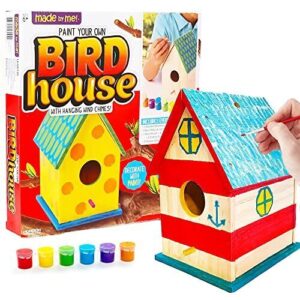
The DIY Birdhouse Kit Build and Paint is a fun, hands-on project perfect for kids and adults alike.
It includes seven pre-cut wooden pieces, six vibrant paint pots, a paintbrush, glue, and hemp cording for easy hanging.
The pre-cut pieces fit together with glue, making assembly a breeze—no tools needed!
Decorating is a highlight, with bold paint colors that allow you to express creativity.
Ideal for family bonding or solo crafting, this kit encourages artistic expression while creating a cozy home for backyard birds.
Best For: Creative kids and adults seeking a hands-on, screen-free activity to enjoy alone or with family.
- Easy to assemble with pre-cut wood and no tools required.
- Encourages creativity with vibrant paint options and decoration possibilities.
- Suitable for family bonding and group activities.
- Glue provided may arrive dried out and require replacement.
- Paint drying times may extend the project across multiple days.
- Stickers included may not adhere well long-term.
2. DIY Wooden Bird House Kit

This wooden birdhouse kit is perfect for families or creative individuals.
It includes sturdy cedar pieces, pre-drilled holes, decorative shingles, and a full-color guide—making assembly simple and frustration-free.
You’ll only need a hammer, everything else is included.
Customize it with the paint set, brushes, and sandpaper.
Whether crafting with kids or adding flair to your backyard, this kit combines fun, creativity, and purpose.
Plus, it’s designed to attract Eastern bluebirds or wrens, making it both functional and environmentally friendly.
Best For: Families, creative individuals, and bird enthusiasts looking for a fun and educational DIY project that promotes bonding and environmental care.
- Easy assembly with pre-drilled cedar pieces and full-color instructions.
- Includes paint, brushes, and sandpaper for customization.
- Designed to attract Eastern bluebirds and wrens, combining functionality with creativity.
- Hammer not included, requiring a separate purchase.
- Some users reported missing components in open-box purchases.
- Provided glue may not be as strong as alternatives like Gorilla Wood Glue.
3. Kids Birdhouse Kit to Paint

If your kids love painting and building, this birdhouse kit offers the best of both worlds!
It includes pre-drilled wooden pieces, paint, and a brush for easy assembly and creative fun.
With its 1-inch opening, it’s perfect for small birds like chickadees.
Adult supervision guarantees a safe, frustration-free experience.
Customize it with stickers or your favorite colors, and let their imagination soar!
It’s a great hands-on activity for fostering creativity and a love for nature.
Best For: Young children aged 5-12 who enjoy creative hands-on projects and painting activities with adult supervision.
- Includes pre-drilled wooden pieces for easy assembly.
- Comes with paint, brush, and stickers for customization.
- Encourages creativity and a connection to nature.
- Limited paint quality may require additional supplies.
- Not ideal for older children looking for a more advanced project.
- Lightweight material prone to damage if mishandled.
4. Kids Bird House Build and Paint

If you’re looking for a creative activity, the Kids Bird House Build and Paint kit is a great pick.
It includes pre-drilled holes, making assembly frustration-free. Packed with stickers, paint, and brushes, it turns into the perfect afternoon project for kids aged 6 and up.
The 1.12-inch entrance is ideal for wrens, adding wildlife charm to your backyard.
Don’t forget adult supervision during assembly; it’s a fun way to bond! This kit makes crafting rewarding and nature-friendly.
Best For: Kids aged 6 and up who enjoy creative and nature-inspired activities.
- Pre-drilled holes make assembly easier.
- Includes stickers, paint, and brushes for decoration.
- Encourages creativity and an interest in wildlife.
- Requires adult supervision during assembly.
- Limited to smaller bird species like wrens.
- Some users may find painting materials insufficient.
5. Birdhouse Kit for Kids Craft
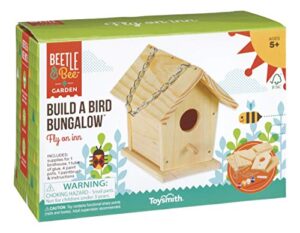
Even if you’re all thumbs in regards to crafts, the Birdhouse Kit for Kids makes building a snap.
It includes pre-cut wood pieces, nails, glue, and vibrant paint pots for endless creative possibilities.
A hanging chain lets you display it outside, attracting chickadees and finches in no time.
Thoughtfully designed for ages 5 and up, it builds confidence, fine motor skills, and a love for nature.
Adults might need to help align nail holes, adding quality bonding time.
Best For: Kids aged 5+ who enjoy creative projects and learning basic woodworking skills with some adult guidance.
- Encourages creativity and fine motor skill development.
- Includes all necessary materials for construction and decoration.
- Functional birdhouse that attracts birds like chickadees and finches.
- Pre-drilled nail holes may be difficult to align.
- Limited paint colors included; additional materials may be needed.
- Final product may feel loose even when fully assembled.
6. Kids Birdhouse DIY Craft Kit
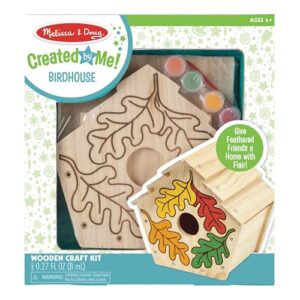
A perfect project for creative little hands, this Kids Birdhouse DIY Craft Kit offers an exciting mix of fun and learning.
With smooth, pre-cut wood, it’s easy to assemble without frustration, while vibrant paints let kids’ imaginations soar.
Pre-drilled holes make the process straightforward, encouraging confidence in young builders, and the kit promotes motor skills and hands-on learning.
The kit offers a sense of accomplishment once their masterpiece is complete, and whether placed indoors or in the garden, it’s a delightful way to engage with nature creatively!
Best For: Young children aged 4-7 who enjoy creative, hands-on activities and learning about nature.
- Encourages creativity and fine motor skill development.
- Easy assembly with pre-cut and pre-drilled wooden pieces.
- Includes non-toxic paints and safe materials for kids.
- Entrance hole may be too small for some bird species.
- Requires adult assistance with screws during assembly.
- Paints may not be durable for extended outdoor use.
7. DIY Wooden Birdhouse Kit for Adults
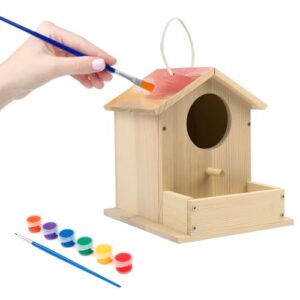
The DIY Wooden Birdhouse Kit for Adults transforms plain wood into an artful sanctuary for birds.
Its eco-friendly pine construction, pre-drilled holes, and upgraded design make assembly simple, no drilling required.
Add a splash of personality with the included paint set and brushes, perfect for customizing your birdhouse.
While it’s durable, extra waterproofing is recommended for outdoor use.
This kit’s creative and hands-on approach fosters connection with nature, making it a fun, screen-free activity with a functional and rewarding end result, providing an opportunity for a unique connection with nature.
Best For: Adults and families seeking a creative, hands-on project that combines crafting with a connection to nature.
- May require additional waterproofing for outdoor durability.
- Balance issues when loaded with birdseed.
- Roof durability concerns in harsh weather conditions.
- Easy assembly with pre-drilled holes and included materials.
- Encourages creativity with paint and decoration options.
- Eco-friendly and suitable for smaller birds.
8. DIY Wooden Birdhouse Building Kit
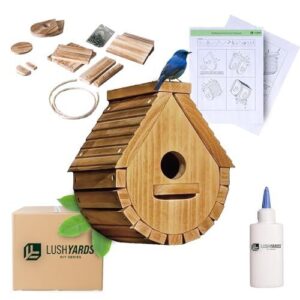
The DIY Wooden Birdhouse Building Kit combines functionality and creativity with ease.
It’s designed for all skill levels, making it great for family bonding or personal relaxation.
The kit is crafted from high-quality pine, and includes everything you need: pre-cut wood, glue, nails, and sandpaper.
The large cleaning door and ventilation guarantee comfort for feathered friends, while its sturdy build promises durability.
Add your personal touch with paint or decorations, and watch nature thrive as birds nest.
It’s a fun way to embrace woodworking and the outdoors!
Best For: Families, hobbyists, and nature lovers seeking a creative and engaging activity that promotes woodworking, education, and birdwatching.
- Complete kit with durable, eco-friendly materials for easy assembly.
- Encourages creativity with options for painting and decorating.
- Functional design with features like a large cleaning door and proper ventilation.
- Some users report alignment issues with parts during assembly.
- Instructions may require extra clarification for beginners.
- Additional sanding might be needed for better component fitting.
9. Build and Paint Birdhouse Kit
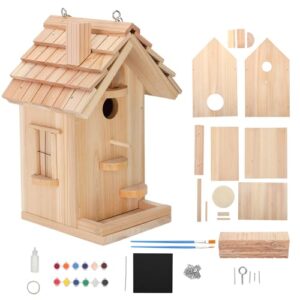
The Build and Paint Birdhouse Kit brings creativity and functionality together.
This easy-to-assemble kit includes pre-cut wood, nails, paintbrushes, and vibrant paints, perfect for customizing your own bird sanctuary.
Ideal for kids 8-12, with adult supervision for younger ones, it’s a fun, hands-on project that fosters bonding and learning.
Pre-drilled holes make assembly a breeze, and adding weatherproof sealant guarantees outdoor durability.
Whether decorating it boldly or keeping it simple, this kit guarantees a rewarding experience for bird lovers of all ages.
Best For: Families and individuals who enjoy creative, hands-on activities and building projects for bonding and outdoor use.
- Easy assembly with pre-drilled holes and pre-cut wood.
- Includes paint, brushes, and accessories for customization.
- Educational and fun for various age groups.
- Paint quantity may not be sufficient for full coverage.
- Hammer not included for assembly.
- Additional weatherproofing needed for outdoor durability.
10. DIY Bird House Kit Outdoor
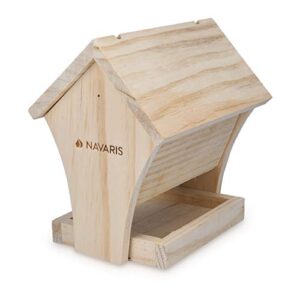
For outdoor enthusiasts, this birdhouse kit is a blend of creativity and purpose.
Crafted for durability, it uses weather-resistant pine wood, ensuring it stands up to the elements. Pre-cut pieces make assembly fun and straightforward, even for beginners.
With a chain included, you can quickly hang it in your garden or balcony. The plain wood design invites you to personalize it with paint or decorations.
Small birds like robins and sparrows will appreciate this cozy haven. It’s nature-meets-DIY simplicity, providing a unique opportunity for outdoor enthusiasts!
Best For: Families and outdoor enthusiasts looking for a creative and educational birdhouse project.
- Made from weather-resistant durable pine wood.
- Easy and fun to assemble with pre-cut pieces.
- Includes a chain for convenient hanging.
- Some parts may require adjustments during assembly.
- Smaller size than expected for some buyers.
- Dowels and holes may not always align perfectly.
Benefits of Building Your Own Birdhouse
You’ll create a safe haven for local birds while developing practical crafting skills when you build your own birdhouse from a kit.
Your handcrafted home provides essential shelter for songbirds and gives you the satisfaction of supporting local wildlife with a project you made yourself, allowing you to feel a sense of satisfaction.
Providing a Safe Haven for Birds
When you assemble a bird house kit, you’re creating more than just a cute yard decoration.
You’re providing essential shelter that helps protect birds from predators, harsh weather, and habitat loss.
Good birdhouse placement—away from cats and other threats—increases nesting safety.
Quality materials and regular cleaning prevent harmful bacteria growth.
Your DIY birdhouse becomes a true bird shelter, offering safe nesting sites for local feathered families.
Attracting Specific Bird Species
How can your DIY birdhouse attract the feathered neighbors you most want to visit? Different bird species have specific housing preferences.
With the right birdhouse kit, you can create homes designed to attract:
- Eastern bluebirds (requiring 1½-inch entrance holes and open placement)
- Wrens (preferring smaller 1¼-inch openings near shrubs)
- Chickadees (attracted to houses mounted 5-15 feet high with nesting material nearby)
Remember, birdhouse size and predator deterrents matter too! Bluebirds also thrive in habitats with short grass nearby.
Customization and Personalization
In the context of birdhouse customization, the possibilities are endless.
You can paint your own birdhouse with vibrant colors, add decor like tiny rocks or butterflies, or modify the kit for unique designs.
Personal touches, like stenciled patterns or succulents, make it truly yours.
Birdhouse decoration ideas let your creativity shine, transforming it into a one-of-a-kind masterpiece, with vibrant colors that showcase your personal style.
Educational and Fun for All Ages
When you build a birdhouse with your family, it’s more than just a project—it’s bonding time.
Birdhouse kits spark creative expression, teaching kids and adults alike valuable skills like problem-solving and fine motor development.
Plus, observing birds fosters nature appreciation and outdoor learning. A kids birdhouse kit turns DIY birdhouse projects into fun, educational family projects everyone will remember.
Features to Look for in a Birdhouse Kit
When picking a birdhouse kit, you’ll want materials that can handle the weather and designs that guarantee proper ventilation and easy cleaning.
Look for kits with pre-cut boards and enough space for birds to nest comfortably, making assembly simple and effective.
Durable and Weather-Resistant Materials
When picking a wooden birdhouse kit, look for weather-resistant options like cedar birdhouses for natural durability or pine birdhouses treated for extra strength.
Recycled plastic offers unmatched longevity and low maintenance. Material waterproofing guarantees birdhouse durability against rain and snow.
Consider exploring various cedar birdhouse designs for inspiration. With the right birdhouse materials, you’re not just crafting; you’re building a cozy home for feathered friends.
Easy-to-Clean Design and Ventilation
When choosing DIY birdhouse kits, think about cleaning frequency and ventilation importance.
A good birdhouse design includes removable panels for easy access and pre-drilled holes for airflow.
Drainage solutions, like small floor holes, prevent water buildup.
Material choices, like cedar or recycled plastic, resist pests and rot.
These features make birdhouse construction simple while keeping your feathered tenants healthy and happy.
Adequate ventilation prevents temperature and humidity from harming nesting birds, ensuring a healthy environment.
Ample Room for Nesting and Raising Young
When picking birdhouse kits, think about nesting space needs. Birds like chickadees or bluebirds need room for their brood size. Tight spaces can lower fledgling success rates.
Look for DIY birdhouses with these features:
- Spacious birdhouse dimensions for comfort.
- Enough room for bird nesting sites.
- Proper songbird shelter design.
- Accommodates growing families.
- Supports natural bird habitat needs.
Consider the benefits of spacious birdhouse kits for ideal bird health.
Pre-Cut Boards and Assembly Materials
A great birdhouse kit saves you from cutting boards yourself.
Pre-cut wood types, like cedar or pine, guarantee material quality and assembly ease.
With included hardware like nails and glue, these kits simplify woodworking.
Kit complexity varies, so beginners can enjoy DIY birdhouses without stress.
Plus, pre-drilled holes prevent splitting, making birdhouse building straightforward and fun for all skill levels, with pre-cut wood types ensuring ease of assembly.
Customizing and Maintaining Your Birdhouse
Customizing and maintaining your birdhouse guarantees it’s both functional and inviting for feathered visitors.
By adding proper ventilation, using weather-resistant finishes, and keeping it clean, you’ll create a safe, long-lasting home for birds to enjoy.
Adding Drainage and Ventilation Holes
For proper ventilation and drainage, add holes to your birdhouse kits.
Place them near the roof and base for airflow and water runoff.
Use these tips:
- Hole Placement: Avoid drafts by spacing holes evenly.
- Hole Size: Keep them small to prevent pests.
- Drainage Materials: Line the base with mesh to channel water away.
Proper ventilation guarantees nestling health.
Birdhouse plans thrive with these DIY tweaks!
Using Weather-Resistant Paint or Stain
A weather-resistant finish is a must for birdhouse kits.
Use waterproofing sealants or outdoor-rated paint for durability.
Stain options highlight wood grain while protecting against rain.
Apply thin, even coats for long-lasting results.
Bright color choices can attract birds and add charm.
Birdhouse painting isn’t just fun—it’s essential for preserving your birdhouse woodworking and designs against the elements.
For maximum protection, consider using specialized outdoor paint designed for birdhouses.
Choosing Bird-Friendly Materials
When picking materials for birdhouse kits, think ecofriendliness and bird safety.
Wooden birdhouse kits, especially cedar, last long and attract birds naturally. Recycled materials, like plastic, are durable but make certain they’re non-toxic. Paint safety matters too—opt for water-based, bird-safe options.
- Use natural wood types for material longevity.
- Avoid harmful plastic concerns.
- Prioritize bird conservation and ensure the materials used are safe for the birds, considering the importance of non-toxic elements.
Cleaning and Disinfecting The Birdhouse
You should clean your birdhouse at least twice a year to prevent mold and parasites.
Use mild disinfectant options like diluted vinegar, and always wear gloves for safety precautions.
Remove old nesting materials, scrub gently, and rinse thoroughly.
Dry completely before reassembly.
Regular birdhouse maintenance supports bird conservation as well as keeps your birdhouse supplies and accessories in top shape.
Tips for Installing and Enjoying Your Birdhouse
Placing your birdhouse correctly guarantees it becomes a safe, welcoming home for feathered visitors.
By focusing on location, direction, and upkeep, you’ll create a thriving spot for birds to nest and raise their young.
Choosing The Right Location and Height
Finding the right spot for your birdhouse is key to attracting feathered friends.
Consider these tips:
- Height: Place it 5-10 feet above ground for most species.
- Predator Avoidance: Avoid areas near dense shrubs or predator access points.
- Sun Exposure: Choose partial shade to prevent overheating.
- Wind Protection: Face away from prevailing winds for a cozy, safe habitat.
Facing The Birdhouse in The Right Direction
To guarantee happy tenants, face your birdhouse north, northeast, or east. This avoids harsh Sunlight Exposure and shields from strong Weather Patterns.
Consider Wind Direction to keep nests cozy and dry. Predator Avoidance matters too—keep it secure and away from feeders.
Aligning birdhouse placement with Bird Species preferences enhances bird observation and your birdhouse designs’ success.
| Direction | Sunlight Exposure | Wind Protection | Attracts Birds? |
|---|---|---|---|
| North | Low | High | Yes |
| Northeast | Minimal | Good | Yes |
| East | Moderate | Moderate | Yes |
| South | High | Poor | No |
Ensuring Proper Ventilation and Drainage
Good ventilation and drainage keep your birdhouse cozy and mold-free.
Place holes near the top for airflow and at the bottom for moisture control. Proper hole placement prevents soggy nests, a common issue in poorly designed birdhouses.
One key factor is to make certain proper air circulation for nestling health. Follow birdhouse building tips to avoid moisture buildup, ensuring healthy environments for birds.
Thoughtful designs boost birdhouse benefits and make assembly a rewarding experience.
Replacing Old Nesting Materials and Debris
Think of your birdhouse as a seasonal apartment for birds.
Regular nesting material removal prevents disease and parasite control issues.
After each season, clean out old debris, ensuring a fresh start for new tenants.
Safe disposal of nesting materials is key—avoid scattering them near the birdhouse.
These birdhouse building tips keep your DIY project functional and inviting year-round.
Frequently Asked Questions (FAQs)
How to attract specific bird species?
Ever wonder why some birds skip your yard?
Offer nesting materials like twigs, add water sources, and use species-specific feeders.
Plant native flowers and shrubs—they’re like bird magnets, creating a cozy, irresistible habitat, making your yard a place where birds will want to stay with native flowers.
What tools are needed to assemble kits?
You’ll need just a hammer for most kits since they include pre-drilled holes, nails, wood glue, and sandpaper.
Everything else, like paint, brushes, and decorative elements, is already packed for you!
Are kits suitable for young children?
Yes, kits are perfect for young children aged 6 and up.
With pre-drilled holes, easy instructions, and tool-free assembly, they’re a fun, creative way to build confidence and bond with family.
Can kits be built without prior experience?
Building these kits is as easy as pie!
With pre-drilled holes, clear instructions, and included materials, you don’t need experience.
Just grab a hammer, follow the steps, and enjoy crafting something truly unique.
Do kits withstand different weather conditions?
Most kits hold up well outdoors if you apply a waterproof sealant like polyurethane.
Without it, prolonged exposure to rain or harsh weather might cause wear.
Proper sealing guarantees durability, letting your creation thrive through seasons.
Are tools required for assembling the birdhouse kit?
You won’t need fancy tools—just a hammer.
The kit includes pre-drilled holes, nails, and wood glue for easy assembly.
It’s designed for all ages, so no power drills or advanced skills are required.
Can the kits be used indoors as decor?
Why let birds have all the fun?
These kits double as charming indoor decor.
Paint them, add succulents or fairy lights, and voilà—your living room gets a cozy, whimsical touch that’s uniquely yours.
What age group is ideal for these kits?
These kits are perfect for ages 6 and up, offering fun for kids, teens, and adults alike.
Younger children benefit from adult guidance, while older users enjoy the creative challenge and hands-on learning experience.
Are replacement parts available for damaged pieces?
If a piece gets damaged, don’t worry—you can usually request replacements directly from the manufacturer.
Check the kit’s packaging or website for contact details, and they’ll guide you through getting the right parts.
How can the birdhouse be made weatherproof?
Seal the birdhouse with polyurethane to waterproof it, ensuring durability against rain.
Apply evenly, let it dry completely, and repeat if needed.
For extra flair, add weather-resistant decorations like rocks or painted designs.
Conclusion
A birdhouse kit is like a blank canvas, inviting you to create something both functional and beautiful.
With build your own bird house kits, you’re not just building a shelter—you’re crafting a safe space for birds while enjoying hands-on creativity.
These kits offer a fun, educational experience for all ages, teaching skills and fostering a connection to nature.
Choose durable materials, customize thoughtfully, and install wisely to attract feathered friends and make your outdoor space truly special.

